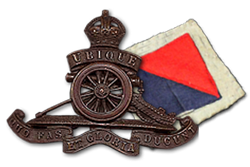The Robin Hood Battalion was a unit of the Volunteer Force of the British Army and Territorial Force, later the Territorial Army. The battalion served as infantry on the Western Front during World War I. In the 1930s it re-roled as an anti-aircraft unit and served in World War II, including North-western Europe from June 1944 to May 1945.

The Norfolk Yeomanry was a volunteer cavalry (Yeomanry) regiment of Britain's Territorial Army accepted onto the establishment of the British Army in 1794. After seeing action in the Second Boer War, it served dismounted at Gallipoli, in Palestine and on the Western Front during the First World War. Between the wars it converted to the Royal Artillery (TA), and served as an anti-tank regiment in France, the Western Desert, Italy and North West Europe during the Second World War. After the war it served as a TA air defence unit and then as an Army Air Corps unit.
30th (Surrey) Searchlight Regiment was an air defence unit of Britain's Territorial Army from 1924 until 1961. During World War II it served in The Blitz and later in the Tunisian and Italian Campaigns, while detachments from the regiment served in the Far East and were captured at the Fall of Singapore.
The 32nd (Midland) Anti-Aircraft Brigade was an air defence formation of Anti-Aircraft Command in Britain's Territorial Army (TA) from 1936 to 1955, charged with defending the East Midlands of England.
58th (Middlesex) Searchlight Regiment, Royal Artillery was an air defence unit of Britain's Territorial Army (TA) raised just before World War II. It defended the East Midlands of England during The Blitz, and later served as infantry in North West Europe at the end of the war, converting to the anti-aircraft (AA) artillery role postwar.

The 51st (Highland) Searchlight Regiment, Royal Artillery was a Scottish unit of Britain's Territorial Army (TA) formed for air defence just before World War II. It later served as an anti-aircraft (AA) artillery unit in the North West Europe Campaign 1944–45.

The 59th (Warwickshire) Searchlight Regiment, Royal Artillery was an air defence unit of the Territorial Army (TA), part of the British Army, and was raised in Birmingham in 1938 just before the Second World War.
The 37th Searchlight Regiment, Royal Artillery was an air defence unit of Britain's Territorial Army (TA) during World War II. It served in the Battle of France, when it was one of the last British units evacuated. It then served in Anti-Aircraft Command defending the UK, particularly against V-1 flying bombs.
The 37th Light Anti-Aircraft Regiment, Royal Artillery was an air defence unit of the British Army during World War II. It served at home during the Battle of Britain and The Blitz, and then went to the Middle East, where it defended the lines of communication of the Eighth Army in its advance across North Africa after the Battle of El Alamein and in the Tunisian Campaign.

The Dundee Fortress Royal Engineers was a Scottish volunteer unit of the British Army formed in 1908. Its main role was the defence of the harbours and shipyards on the River Tay, but it also provided a detachment that saw active service in North Russia at the end of World War I. In the 1930s, it was turned into an air defence unit, in which role it served in World War II. A brief postwar revival ended in disbandment in 1950.

72nd (Middlesex) Searchlight Regiment, Royal Artillery was an air defence unit of Britain's Territorial Army (TA) raised just before the outbreak of World War II, which served as part of Anti-Aircraft Command during and after the war.
The Leicester Town Rifles was an early unit of the British Volunteer Force raised in 1859. It went on to become the parent unit of the Territorial Army battalions of the Leicestershire Regiment, which served on the Western Front during World War I. Their successor unit served in the air defence role during and after World War II.
The High Peak Rifles, later 6th Battalion, Sherwood Foresters, was a volunteer unit of Britain's Territorial Army. First raised in the High Peak area of Derbyshire in 1860, it fought as infantry on the Western Front during World War I and as an air defence unit during World War II. Its descendants remained in the Army Reserve until 2014.

73rd Heavy Anti-Aircraft Regiment, Royal Artillery was a West Midlands-based volunteer air defence unit of Britain's Territorial Army (TA) raised in 1937. During World War II, it served in the Battle of France, The Blitz, Egypt, Sicily and Italy. Postwar, its successor regiments continued to serve until 1967, and a battery descended from the regiment forms part of today's Army Reserve
50th Light Anti-Aircraft Brigade was an air defence formation of Britain's Territorial Army (TA) during World War II. It defended the North Midlands of England during The Blitz and later helped to protect Brussels from V-1 flying bombs during the Campaign in North West Europe.
525th (Antrim) Coast Regiment, Royal Artillery (TA) was a volunteer coastal defence unit of Britain's Territorial Army from 1937 until 1956. It was the first Territorial Army unit to be raised in Northern Ireland.

The 115th Field Regiment was a part-time unit of Britain's Royal Artillery (RA), raised as part of the Territorial Army (TA) just before the outbreak of World War II. It served in the Battle of France and the Burma Campaign, and in the postwar TA.

94th Heavy Anti-Aircraft Regiment, Royal Artillery, was a Scottish air defence unit of Britain's Territorial Army (TA) formed around Edinburgh during the period of international tension leading up to the outbreak of World War II. It defended Eastern Scotland during the early part of the war and then served in the North African Campaign. The regiment continued in the postwar TA until amalgamated in 1955










